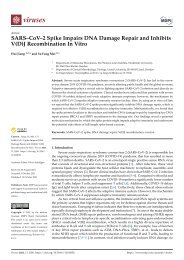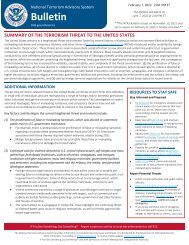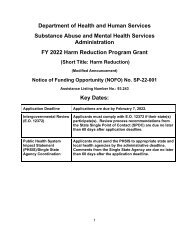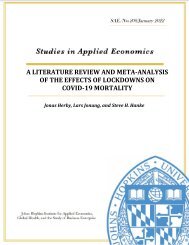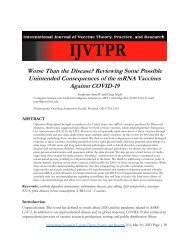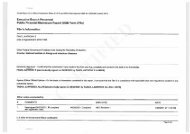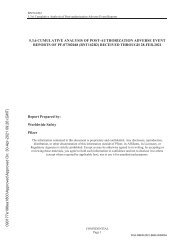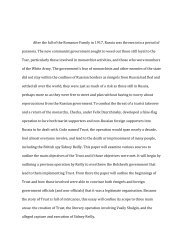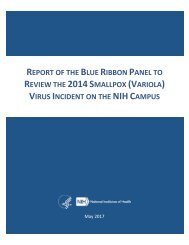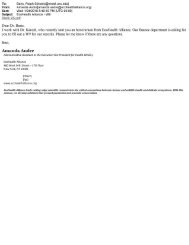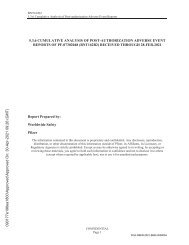MSH3 Homology and Potential Recombination Link to SARS-CoV-2 Furin Cleavage Site
Create successful ePaper yourself
Turn your PDF publications into a flip-book with our unique Google optimized e-Paper software.
PERSPECTIVE<br />
published: 21 February 2022<br />
doi: 10.3389/fviro.2022.834808<br />
<strong>MSH3</strong> <strong>Homology</strong> <strong>and</strong> <strong>Potential</strong><br />
<strong>Recombination</strong> <strong>Link</strong> <strong>to</strong> <strong>SARS</strong>-<strong>CoV</strong>-2<br />
<strong>Furin</strong> <strong>Cleavage</strong> <strong>Site</strong><br />
BalamuraliK.Ambati 1 ,AkhilVarshney 2 ,KennethLundstrom 3 *,GiorgioPalú 4 ,<br />
BruceD.Uhal 5 ,VladimirN.Uversky 6 <strong>and</strong>AdamM.Brufsky 7<br />
1<br />
Knight’sCampusforAcceleratingScientificImpact,UniversityofOregon,Eugene,OR,UnitedStates, 2 Dr.Shroff’sCharity<br />
EyeHospital,NewDelhi,India, 3 PanTherapeutics,Lutry,Switzerl<strong>and</strong>, 4 Departmen<strong>to</strong>fMolecularMedicine,Universityof<br />
Padova,Padova,Italy, 5 Departmen<strong>to</strong>fPhysiology,MichiganStateUniversity,EastLansing,MI,UnitedStates, 6 Department<br />
ofMolecularMedicine,MorsaniCollegeofMedicine,UniversityofSouthFlorida(USF)HealthByrdAlzheimer’sInstitute,<br />
UniversityofSouthFlorida,Tampa,FL,UnitedStates, 7 DivisionofHema<strong>to</strong>logy/Oncology,Departmen<strong>to</strong>fMedicine,University<br />
ofPittsburghMedicalCenter(UPMC)HillmanCancerCenter,UniversityofPittsburghSchoolofMedicine,Pittsburgh,PA,<br />
UnitedStates<br />
Editedby:<br />
XinYin,<br />
HarbinVeterinaryResearchInstitute,<br />
ChineseAcademyofAgricultural<br />
Sciences(CAAS),China<br />
Reviewedby:<br />
JitaoChang,<br />
HarbinVeterinaryResearchInstitute,<br />
ChineseAcademyofAgricultural<br />
Sciences(CAAS),China<br />
*Correspondence:<br />
KennethLundstrom<br />
lundstromkenneth@gmail.com<br />
Specialtysection:<br />
Thisarticlewassubmitted<strong>to</strong><br />
Emerging<strong>and</strong>ReemergingViruses,<br />
asectionofthejournal<br />
FrontiersinVirology<br />
Received:13December2021<br />
Accepted:19January2022<br />
Published:21February2022<br />
Citation:<br />
AmbatiBK,VarshneyA,LundstromK,<br />
PalúG,UhalBD,UverskyVN<strong>and</strong><br />
BrufskyAM(2022)<strong>MSH3</strong><strong>Homology</strong><br />
<strong>and</strong><strong>Potential</strong><strong>Recombination</strong><strong>Link</strong><strong>to</strong><br />
<strong>SARS</strong>-<strong>CoV</strong>-2<strong>Furin</strong><strong>Cleavage</strong><strong>Site</strong>.<br />
Front.Virol.2:834808.<br />
doi:10.3389/fviro.2022.834808<br />
Among numerous point mutation differences between the <strong>SARS</strong>-<strong>CoV</strong>-2 <strong>and</strong> the bat<br />
RaTG13 coronavirus, only the 12-nucleotide furin cleavage site (FCS) exceeds 3<br />
nucleotides. A BLAST search revealed that a 19 nucleotide portion of the <strong>SARS</strong>.Cov2<br />
genome encompassing the furing cleavage site is a 100% complementary match <strong>to</strong> a<br />
codon-optimized proprietary sequence that is the reverse complement of the human<br />
mutS homolog (<strong>MSH3</strong>). The reverse complement sequence present in <strong>SARS</strong>-<strong>CoV</strong>-2<br />
may occur r<strong>and</strong>omly but other possibilities must be considered. <strong>Recombination</strong> in an<br />
intermediatehostisanunlikelyexplanation.Singlestr<strong>and</strong>edRNAvirusessuchas<strong>SARS</strong>-<br />
<strong>CoV</strong>-2 utilize negative str<strong>and</strong> RNA templates in infected cells, which might lead through<br />
copy choice recombination with a negative sense <strong>SARS</strong>-<strong>CoV</strong>-2 RNA <strong>to</strong> the integration<br />
of the <strong>MSH3</strong> negative str<strong>and</strong>, including the FCS, in<strong>to</strong> the viral genome. In any case,<br />
the presence of the 19-nucleotide long RNA sequence including the FCS with 100%<br />
identity <strong>to</strong> the reverse complement of the <strong>MSH3</strong> mRNA is highly unusual <strong>and</strong> requires<br />
further investigations.<br />
Keywords: <strong>SARS</strong>-<strong>CoV</strong>-2 spike, furin cleavage site, <strong>MSH3</strong> gene, sequence homology, recombinability<br />
INTRODUCTION<br />
Based on a recent publication describing insertion variants of <strong>SARS</strong>-<strong>CoV</strong>-2 (1) we would like <strong>to</strong><br />
bringtheattention<strong>to</strong>ourrecentfindingsrelated<strong>to</strong>thesequenceofthefurincleavagesite(FCS)in<br />
<strong>SARS</strong>-<strong>CoV</strong>-2 Spike (S) protein. The<strong>SARS</strong>-<strong>CoV</strong>-2 causingthe COVID-19p<strong>and</strong>emic (2) has82.3%<br />
amino acid identity <strong>to</strong> bat coronavirus SL-<strong>CoV</strong>ZC45, 77.2% amino acid identity <strong>to</strong> <strong>SARS</strong>-<strong>CoV</strong>,<br />
<strong>and</strong>96.2%genomesequenceidentity<strong>to</strong>batcoronavirusRaTG13.Whilenumerouspointmutation<br />
differencesexistbetween<strong>SARS</strong>-<strong>CoV</strong>-2<strong>and</strong>RaTG13,onlyoneinsertion<strong>and</strong>dissimilarityexceeding<br />
3nucleotides(nt):a12-nucleotideinsertioncodingforfouraminoacids(aa681-684,PRRA)inthe<br />
<strong>SARS</strong>-<strong>CoV</strong>-2S protein has been discovered. This polybasic FCS differentiates <strong>SARS</strong>-<strong>CoV</strong>-2 from<br />
other b-lineage betacoronaviruses or any other sarbecovirus (3). An FCS addition enhanced the<br />
infectivity of <strong>SARS</strong> Co-V-2 in 2019 (4). The absence of this FCS results in attenuated <strong>SARS</strong>-<strong>CoV</strong>-<br />
2 variants useful for animal vaccination, accentuating its relevance <strong>to</strong> human infection (5). This<br />
FCSisvitalforhuman<strong>and</strong>ferrettransmission(6),exp<strong>and</strong>sviraltropism<strong>to</strong>humancells(7),<strong>and</strong>is<br />
requisiteforseverediseaseintwoanimalmodelsof<strong>SARS</strong>-<strong>CoV</strong>-2(8).<br />
Frontiers in Virology | www.frontiersin.org 1 February 2022 | Volume 2 | Article 834808
Ambati et al.<br />
<strong>MSH3</strong> <strong>and</strong> <strong>SARS</strong>-<strong>CoV</strong>-2 Spike <strong>Homology</strong><br />
FIGURE 1 | The origin of the furin sequence in <strong>SARS</strong>-<strong>CoV</strong>-2. Comparison of the protein sequences at the S1/S2 junction in <strong>SARS</strong>-<strong>CoV</strong>, RaTG13, <strong>and</strong> <strong>SARS</strong>-<strong>CoV</strong>-2<br />
demonstrating the presence of the furin cleavage site (FCS) PRRA only in <strong>SARS</strong>-<strong>CoV</strong>-2. Based on a BLAST search of the 12-nucleotide stretch coding for the FCS<br />
PRRA, a 19-nucleotide long identical sequence was identified in the patented (US 958 7003) sequence Seq ID11652. SEQ ID11652 is transcribed <strong>to</strong> a <strong>MSH3</strong> mRNA<br />
that appears <strong>to</strong> be codon optimized for humans. This 19-nucleotide sequence including 12 nucleotides coding for the FCS PRRA, present in the human <strong>MSH3</strong> gene<br />
might have been introduced in<strong>to</strong> the <strong>SARS</strong>-<strong>CoV</strong>-2 genome by the illustrated copy choice recombination mechanism in <strong>SARS</strong>-<strong>CoV</strong>-2 infected human cells<br />
overexpressing the <strong>MSH3</strong> gene.<br />
<strong>SARS</strong>-COV-2 SPIKE PROTEIN AND <strong>MSH3</strong><br />
A peculiar feature of the nucleotide sequence encoding the<br />
PRRA furin cleavage site in the <strong>SARS</strong>-<strong>CoV</strong>-2S protein is its<br />
two consecutive CGG codons. This arginine codon is rare in<br />
coronaviruses:relativesynonymouscodonusage(RSCU)ofCGG<br />
in pangolin <strong>CoV</strong> is 0, in bat <strong>CoV</strong> 0.08, in <strong>SARS</strong>-<strong>CoV</strong> 0.19, in<br />
MERS-<strong>CoV</strong>0.25,<strong>and</strong>in<strong>SARS</strong>-<strong>CoV</strong>-20.299(9).<br />
A BLAST search for the 12-nucleotide insertion led us <strong>to</strong> a<br />
100% reverse match in a proprietary sequence (SEQ ID11652,<br />
nt 2751-2733) found in the US patent 9,587,003 filed on Feb.<br />
4, 2016 (10) (Figure1). Examination of SEQ ID11652 revealed<br />
that the match extends beyond the 12-nucleotide insertion <strong>to</strong><br />
a 19-nucleotide sequence: 5 ′ -CTACGTGCCCGCCGAGGAG-<br />
3 ′ (nt 2733-2751 of SEQ ID11652), such that the resulting<br />
mRNA would have 3 ′ - GAUGCACGGGCGGCUCCUC-5 ′ , or<br />
equivalently 5 ′ - CU CCU CGG CGG GCA CGU AG-3 ′<br />
(nucleotides 23547-23565 in the <strong>SARS</strong>-<strong>CoV</strong>-2 genome, in which<br />
the four bold codons yield PRRA, amino acids 681–684 of its<br />
spikeprotein).ThisisveryrareintheNCBIBLASTdatabase.<br />
The correlation between this <strong>SARS</strong>-<strong>CoV</strong>-2 sequence <strong>and</strong><br />
the reverse complement of a proprietary mRNA sequence<br />
is of uncertain origin. Conventional biostatistical analysis<br />
indicates that the probability of this sequence r<strong>and</strong>omly being<br />
Frontiers in Virology | www.frontiersin.org 2 February 2022 | Volume 2 | Article 834808
Ambati et al.<br />
<strong>MSH3</strong> <strong>and</strong> <strong>SARS</strong>-<strong>CoV</strong>-2 Spike <strong>Homology</strong><br />
FIGURE 2 | Calculations of the probability of natural occurrence of the 19nt sequence under study. The <strong>SARS</strong>-<strong>CoV</strong>-2 genome is ∼30,000 nucleotides long (P1). The<br />
patented sequence is ∼3,300 nucleotides long (P2). The patented library encompasses 24’712 sequences of varying lengths with median length being in the range of<br />
3,300 nucleotides. Conventional probability calculations are given of the probability of the presence of a 19-nucleotide sequence in the human genome <strong>and</strong> in one of<br />
the patented library sequences.<br />
present in a 30,000-nucleotide viral genome is 3.21 × 10 −11<br />
(Figure2).<br />
The proprietary sequence SEQ ID11652, read in the forward<br />
direction, encodes a 100% amino acid match <strong>to</strong> the human mut<br />
S homolog 3 (<strong>MSH3</strong>) (9). <strong>MSH3</strong> is a DNA mismatch repair<br />
protein (part of the MutS beta complex) (11). SEQ ID11652<br />
is transcribed <strong>to</strong> a <strong>MSH3</strong> mRNA that appears <strong>to</strong> be codon<br />
optimized for humans (12). We did not find the 19-nucleotide<br />
sequence CTCCTCGGCGGGCACGTAG in any eukaryotic or<br />
viral genomes except <strong>SARS</strong>-<strong>CoV</strong>-2 with 100% coverage <strong>and</strong><br />
identityintheBLASTdatabase (SupplementaryTables1–3).<br />
DISCUSSION<br />
<strong>MSH3</strong> replacement with a codon-optimized mRNA sequence<br />
for human expression likely has applications in cancers with<br />
mismatch repair deficiencies. While a portion of a reverse<br />
complement sequence being present in <strong>SARS</strong>-<strong>CoV</strong>-2 could be a<br />
r<strong>and</strong>omcoincidence,otherpossibilitiesmeritconsideration.<br />
Overexpressionof<strong>MSH3</strong>isknown<strong>to</strong>interferewithmismatch<br />
repair (MSH2 sequestration from the MutS alpha complex<br />
comprising MSH2 <strong>and</strong> MSH6 results in MSH6 degradation <strong>and</strong><br />
MutS alpha depletion) (13), which holds virologic importance.<br />
Induction of DNA mismatch repair deficiency results in<br />
permissiveness of influenza A virus (IAV) infection of human<br />
respira<strong>to</strong>ry cells <strong>and</strong> increased pathogenicity (14). Mismatch<br />
repairdeficiencymayextendsheddingof<strong>SARS</strong>-<strong>CoV</strong>-2(15,16).<br />
The absence of CTCCTCGGCGGGCACGTAG from any<br />
eukaryotic or viral genome in the BLAST database makes<br />
recombination in an intermediate host an unlikely explanation<br />
for its presence in <strong>SARS</strong>-<strong>CoV</strong>-2. A human-codon-optimized<br />
mRNA encoding a protein 100% homologous <strong>to</strong> human <strong>MSH3</strong><br />
could, during the course of viral research, inadvertently or<br />
intentionally induce mismatch repair deficiency in a human<br />
cell line, which would increase susceptibility <strong>to</strong> <strong>SARS</strong>-like<br />
viral infection. Infection of SEQ ID11652-<strong>MSH3</strong>-transduced<br />
human cells by a <strong>SARS</strong>-like virus could enable copy choice<br />
recombination(15).Replicationof<strong>SARS</strong>-<strong>CoV</strong>-2<strong>and</strong>othersingle<br />
str<strong>and</strong>ed RNA viruses with an RNA genome of positive polarity<br />
is initiated by the synthesis of negative str<strong>and</strong> RNA in the<br />
cy<strong>to</strong>plasm of infected cells (17) (Figure1). The negative str<strong>and</strong><br />
RNAisatemplateforsynthesisofpositivestr<strong>and</strong>edRNAutilized<br />
for translation of non-structural proteins, the replication <strong>and</strong><br />
transcription complex, or new virion capsids. Coronaviruses<br />
generate double str<strong>and</strong>ed RNA at an early stage of infection<br />
throughgenomicreplication<strong>and</strong>mRNAtranscription(18).<br />
Frontiers in Virology | www.frontiersin.org 3 February 2022 | Volume 2 | Article 834808
Ambati et al.<br />
<strong>MSH3</strong> <strong>and</strong> <strong>SARS</strong>-<strong>CoV</strong>-2 Spike <strong>Homology</strong><br />
AcquisitionofthereversecomplementFCSsequencefroman<br />
overexpressed positive sense <strong>MSH3</strong> mRNA could occur through<br />
copy choice recombination with a negative sense <strong>SARS</strong>-<strong>CoV</strong>-2<br />
RNA intermediate (15), involving jumping from one template<br />
<strong>to</strong> another (19) (Figure1). The homology between <strong>SARS</strong>-<strong>CoV</strong>-<br />
2 <strong>and</strong> other known coronaviruses is discontinued <strong>and</strong> most<br />
<strong>SARS</strong>-<strong>CoV</strong>-2 sequences derive from a relatively recent common<br />
ances<strong>to</strong>rwithbatRaTG13.Moreover,similarityplots(SimPlots)<br />
have identified sudden changes in sequence identity between<br />
<strong>SARS</strong>-<strong>CoV</strong>-2 <strong>and</strong> RaTG13, signaling potential recombination<br />
events, which could explain the capability of <strong>SARS</strong>-<strong>CoV</strong>-2<br />
binding <strong>to</strong> ACE2 through its RBD, which is not the case for the<br />
RaTG13RBD(15).<br />
A criticism of this hypothesis is that the identified sequence<br />
is on the opposite str<strong>and</strong> of the open reading frame in SEQ<br />
ID11652. However, cells transfected with <strong>MSH3</strong>, which induce<br />
mismatch repair deficiency could have targeted double-str<strong>and</strong>ed<br />
cDNA encoding SEQ ID11652. Such cells co-transfected with<br />
a <strong>SARS</strong>-like virus expressing RdRp could attach <strong>to</strong> this 19-<br />
nucleotide sequence (15) <strong>and</strong> permit integration of a fragment<br />
from the negative str<strong>and</strong> in<strong>to</strong> the viral genome, including the<br />
FCS, despite being on the opposite str<strong>and</strong> of the open reading<br />
frame.Mismatchrepairmechanismshaveenabledintegrationof<br />
short fragments from antisense str<strong>and</strong>s in experimental models<br />
(20, 21). Microhomology can direct recombination between the<br />
<strong>MSH3</strong> <strong>and</strong> a <strong>SARS</strong>-like virus, which could take place at the<br />
19-nucleotidesequenceofinterest.<br />
The presence in <strong>SARS</strong>-<strong>CoV</strong>-2 of a 19-nucleotide RNA<br />
sequence encoding an FCS at amino acid 681 of its spike<br />
protein with 100% identity <strong>to</strong> the reverse complement of<br />
a proprietary <strong>MSH3</strong> mRNA sequence is highly unusual.<br />
<strong>Potential</strong> explanations for this correlation should be<br />
furtherinvestigated.<br />
DATA AVAILABILITY STATEMENT<br />
Publicly available datasets were analyzed in this study. This data<br />
canbefoundhere:SEQID11652.<br />
AUTHOR CONTRIBUTIONS<br />
Theinvestigation<strong>and</strong>originaldraftwereinitiatedbyBA,AV,<strong>and</strong><br />
AB. The visualization was performed by BA, AV, AB, <strong>and</strong> GP.<br />
The writing <strong>and</strong> editing were done by BA, AV, KL, GP, BU, VU,<br />
<strong>and</strong> AB. All authors contributed <strong>to</strong> the article <strong>and</strong> approved the<br />
submittedversion.<br />
ACKNOWLEDGMENTS<br />
WearethankfulforthecontributionofDr.JianYing,University<br />
ofUtah,Eureka,USA<strong>to</strong>theprobabilityanalysis.<br />
SUPPLEMENTARY MATERIAL<br />
The Supplementary Material for this article can be found<br />
online at: https://www.frontiersin.org/articles/10.3389/fviro.<br />
2022.834808/full#supplementary-material<br />
REFERENCES<br />
1. Garushyants SK, Rogozin IB, Koonin EV. Template switching <strong>and</strong><br />
duplications in <strong>SARS</strong>-<strong>CoV</strong>-2 genomes give rise <strong>to</strong> insertion variants that<br />
merit moni<strong>to</strong>ring. Commun Biol. (2021) 4:1343. doi: 10.1038/s42003-021-<br />
02858-9<br />
2. WuF, ZhaoS,Yu B,Chen, YM, WangW, SongZG,etal. Anewcoronavirus<br />
associated with human respira<strong>to</strong>ry disease in China. Nature. (2020) 579:265–<br />
9.doi:10.1038/s41586-020-2008-3<br />
3. Coutard B, Valle C, de Lamballerie X, Canard B, Seidah NG,<br />
Decroly E. The spike glycoprotein of the new coronavirus 2019-<br />
n<strong>CoV</strong> contains a furin-like cleavage site absent in <strong>CoV</strong> of the same<br />
clade. Antiviral Res. (2020) 176:104742. doi: 10.1016/j.antiviral.2020.<br />
104742<br />
4. Walls AC, Park YJ, Tor<strong>to</strong>rici MA, Wall A, McGuire AT, Veesler<br />
D. Structure, Function, <strong>and</strong> Antigenicity of the <strong>SARS</strong>-<strong>CoV</strong>-2 Spike<br />
Glycoprotein. Cell. (2020) 181:281–92.e286. doi: 10.1016/j.cell.2020.<br />
02.058<br />
5. Lau SY, Wang P, Mok BWY, Zhang AJ, Chu H, Lee ACY, et al. Attenuated<br />
<strong>SARS</strong>-<strong>CoV</strong>-2 variants with deletions at the S1/S2 junction. Emerg Microbes<br />
Infect.(2020)9:837–42.doi:10.1080/22221751.2020.1756700<br />
6. PeacockTP,GoldhillDH,ZhouJ,BaillonL,FriseR,SwannOC,etal.Thefurin<br />
cleavage site in the <strong>SARS</strong>-<strong>CoV</strong>-2 spike protein is required for transmission<br />
in ferrets. Nat Microbiol. (2020) 6:899–909. doi: 10.1038/s41564-021-<br />
00908-w<br />
7. Xia S, Lan Q, Su S, Wang X, Xu W, Liu Z, et al. The role of furin<br />
cleavage site in <strong>SARS</strong>-<strong>CoV</strong>-2 spike protein-mediated membrane fusion in<br />
the presence or absence of trypsin. Signal Transd. Targeted Ther. (2020)<br />
5:92.doi:10.1038/s41392-020-0184-0<br />
8. Hou W. Characterization of codon usage pattern in <strong>SARS</strong>-<strong>CoV</strong>-2. Virology J.<br />
(2020)17:138.doi:10.1186/s12985-020-01395-x<br />
9. K<strong>and</strong>eelM,IbrahimA,FayezM,Al-NazawiM.From<strong>SARS</strong><strong>and</strong>MERS<strong>CoV</strong>s<br />
<strong>to</strong> <strong>SARS</strong>-<strong>CoV</strong>-2: Moving <strong>to</strong>ward more biased codon usage in viral structural<br />
<strong>and</strong>nonstructuralgenes.JMedVirol.(2020)92:660–6.doi:10.1002/jmv.25754<br />
10. BancelS,ChakrabortyT,DeFougerollesA,ElbashirSM,JohnM,RoyA,etal.<br />
Modified Polynucleotides for the Production of Oncology-Related Proteins <strong>and</strong><br />
Peptides.Cambridge,MA:UnitedStatesPatent.(2016).<br />
11. MacRae SL, McKnight Croken M, Calder RB, Aliper A, Milholl<strong>and</strong> B, White<br />
RR, et al. DNA repair in species with extreme lifespan differences. Aging.<br />
(2015)7:1171–84.doi:10.18632/aging.100866<br />
12. Mauro VP, Chappell SA. A critical analysis of codon optimization<br />
in human therapeutics. Trends Mol Med. (2014) 20:604–<br />
13.doi:10.1016/j.molmed.2014.09.003<br />
13. Marra G, Iaccarino I, Lettieri T, Roscilli G, Delmastro P, <strong>and</strong> Jiricny J.<br />
Mismatch repair deficiency associated with overexpression of the <strong>MSH3</strong><br />
gene. Proc Natl Acad Sci USA. (1998) 95:8568. doi: 10.1073/pnas.95.15.<br />
8568<br />
14. Chambers BS, Hea<strong>to</strong>n BE, Rausch K, Dumm RE, Hamil<strong>to</strong>n JR, Cherry S,<br />
et al. DNA mismatch repair is required for the host innate response <strong>and</strong><br />
controls cellular fate after influenza virus infection. Nat Microbiol. (2019)<br />
4:1964–77.doi:10.1038/s41564-019-0509-3<br />
15. Gallaher WR. A palindromic RNA sequence as a common<br />
breakpoint contribu<strong>to</strong>r <strong>to</strong> copy-choice recombination in <strong>SARS</strong>-<br />
COV-2. Arch Virol. (2020) 165:2341–8. doi: 10.1007/s00705-020-<br />
04750-z<br />
16. Haque F, Lillie P, Haque F, Maraveyas A. Deficient DNA mismatch<br />
repair <strong>and</strong> persistence of <strong>SARS</strong>-<strong>CoV</strong>-2 RNA shedding: a case report<br />
of Hereditary Nonpolyposis Colorectal Cancer with COVID-19<br />
Frontiers in Virology | www.frontiersin.org 4 February 2022 | Volume 2 | Article 834808
Ambati et al.<br />
<strong>MSH3</strong> <strong>and</strong> <strong>SARS</strong>-<strong>CoV</strong>-2 Spike <strong>Homology</strong><br />
infection. BMC Infect Dis. (2020) 21:854. doi: 10.1186/s12879-021-<br />
06500-1<br />
17. V’kovski P, Kratzel A, Steiner S, Stalder H, Thiel V. Coronavirus biology<br />
<strong>and</strong> replication: implications for <strong>SARS</strong>-<strong>CoV</strong>-2. Nat Rev. (2021) 19:155–<br />
70.doi:10.1038/s41579-020-00468-6<br />
18. Graham RL, Baric RS. <strong>Recombination</strong>, reservoirs, <strong>and</strong> the modular spike:<br />
mechanisms of coronavirus cross-species transmission. J Virol. (2010)<br />
84:3146.doi:10.1128/JVI.01394-09<br />
19. Sola I, Almazan F, Zuniga S, Enjuanes L. Continuous <strong>and</strong><br />
discontinuous RNA synthesis in coronaviruses. Annu Rev Virol. (2015)<br />
2:265–88.doi:10.1146/annurev-virology-100114-055218<br />
20. Rakosy-Tican E, Lörincz-Besenyei E, Molnár I, Thieme R, Hartung F,<br />
Sprink T, et al. New Phenotypes of pota<strong>to</strong> co-induced by mismatch<br />
repair deficiency <strong>and</strong> somatic hybridization. Front Plant Sci. (2019)<br />
10:3.doi:10.3389/fpls.2019.00003<br />
21. Harmsen T, Klaasen S, van de Vrugt H, <strong>and</strong> te Riele H. DNA<br />
mismatch repair <strong>and</strong> oligonucleotide end-protection promote<br />
base-pair substitution distal from a CRISPR/Cas9- induced DNA<br />
break. Nucl Acids Res. (2018) 46:2945–55. doi: 10.1093/nar/<br />
gky076<br />
Conflic<strong>to</strong>fInterest:KLwasemployedbyPanTherapeutics.<br />
The remaining authors declare that the research was conducted in the absence of<br />
any commercial or financial relationships that could be construed as a potential<br />
conflic<strong>to</strong>finterest.<br />
Publisher’sNote:Allclaimsexpressedinthisarticlearesolelythoseoftheauthors<br />
<strong>and</strong> do not necessarily represent those oftheir affiliated organizations, or those of<br />
thepublisher,theedi<strong>to</strong>rs<strong>and</strong>thereviewers.Anyproductthatmaybeevaluatedin<br />
this article, or claim that may be made by its manufacturer, is not guaranteed or<br />
endorsedbythepublisher.<br />
Copyright©2022 Ambati,Varshney,Lundstrom,Palú,Uhal,Uversky<strong>and</strong>Brufsky.<br />
This is an open-access article distributed under the terms of the Creative Commons<br />
Attribution License (CC BY). The use, distribution or reproduction in other forums<br />
ispermitted,providedtheoriginalauthor(s)<strong>and</strong>thecopyrigh<strong>to</strong>wner(s)arecredited<br />
<strong>and</strong>thattheoriginalpublicationinthisjournaliscited,inaccordancewithaccepted<br />
academic practice. No use, distribution or reproduction is permitted which does not<br />
complywiththeseterms.<br />
Frontiers in Virology | www.frontiersin.org 5 February 2022 | Volume 2 | Article 834808




